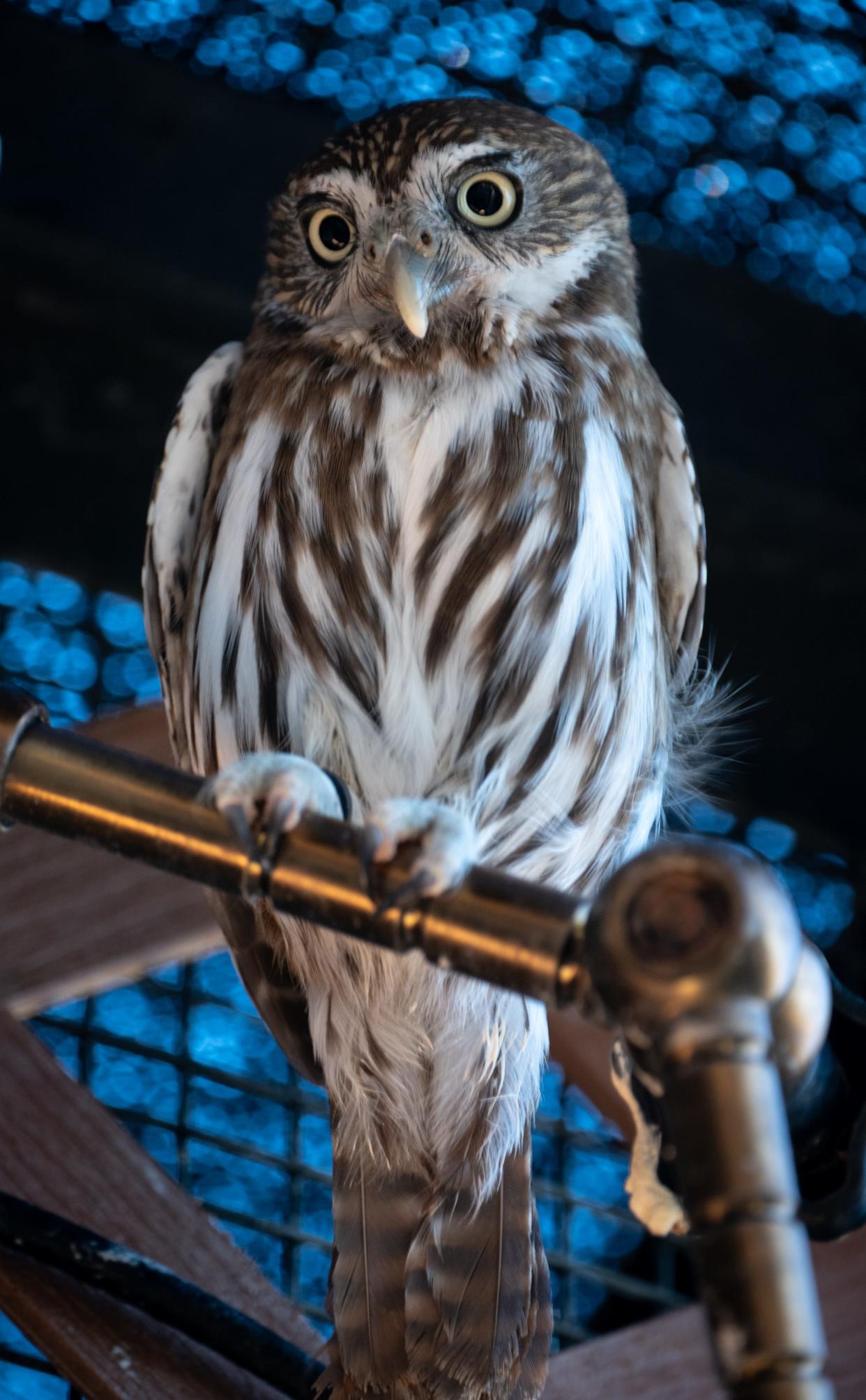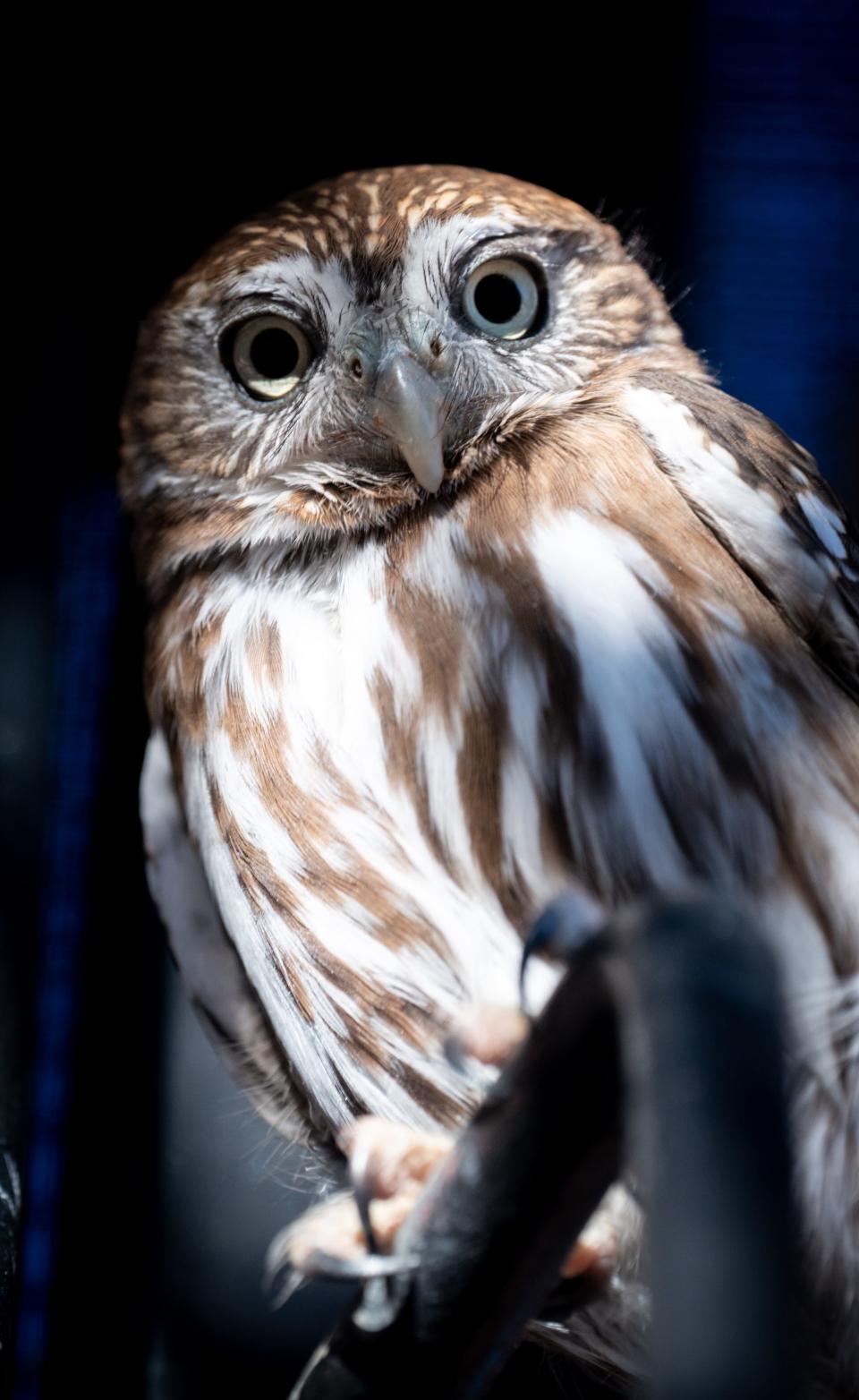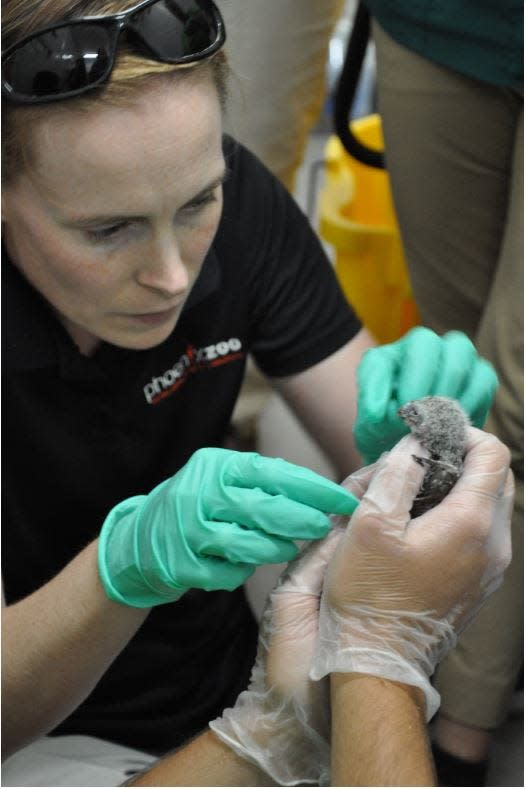The pygmy owl could regain federal protection amid threats by climate change, habitat loss

One of Arizona’s tiniest owls may regain federal protections by the end of the year as climate change, habitat loss and invasive species threaten its future.
The U.S. Fish and Wildlife Service, the agency that manages threatened and endangered species, submitted a proposal in December to classify the cactus ferruginous pygmy owl as threatened under the Endangered Species Act, more than a decade after similar protections were revoked.
The agency is seeking comment from the public on the proposal, which would offer what conservation groups say is a much-needed lifeline to the owl in Arizona. Officials say populations are most fragile in Arizona, although according to the federal assessment, the birds are threatened across their entire range, including Mexico.
Climate change is expected to turn most of the bird's habitat hotter and drier and in turn, affect prey availability and vegetation cover that the birds require for nesting, predator avoidance, and thermoregulation. The clearing of woodlands for agriculture and wood production is also expected to reduce habitat and urban sprawl and development are expected to further encroach into what little habitat is left and diminish connectivity in southern Arizona.
And in eastern Texas, the birds face isolation from larger population groups, such as those in northeastern Mexico, making local extinction more likely.
“If this gets listed, one thing we will do is … pursue whether it's appropriate to designate critical habitat,” said Scott Richardson, a supervisory biologist with the Fish and Wildlife Service. “There's more flexibility with a threatened species than with an endangered species."
He noted that the agency could apply the same protections afforded to an endangered species if needed.
The proposed listing is the result of multi-decade litigation between conservation organizations, local homeowners’ associations and the Fish and Wildlife Service. After being initially listed as an endangered species in 1997, the owl was delisted in 2006 following a lawsuit by the National Association of Home Builders that challenged the designation due to the uncertain significance of the populations in Arizona to larger populations in Mexico.
What ensued highlights the precariousness of protecting an endangered species whose protections preclude development and commerce. While listing decisions are supposed to be based on science, politics and the needs of people can undermine protections. In this case, the birds weren’t delisted because they were recovered, but based on a technicality related to how they were originally listed as a distinct population segment in Arizona.
“Groups opposing protections are essentially trying to use a law which has the purpose of conserving species and ecosystems and preventing extinction against itself for their own political interests,” said Noah Greenwald, endangered species director at the Center for Biological Diversity.
Studies: Owls' future is bleak
Aaron Flesch, a research scientist with the University of Arizona, has spent the better part of two decades monitoring populations of the diminutive owls. He is considered one of the premier scientists studying the tiny owls in the U.S. and Mexico.

"Their populations in Arizona are much smaller now than they were historically and I think that's a really important context here," Flesch said. "The current range size in Arizona is likely less than half of what it was in, let's say, the 1930s or 1920s, before a lot of the riparian environments down in the major valley bottoms were degraded or destroyed by logging or groundwater pumping."
To assess the current status and future outlook for the birds, the agency looked at three factors including representation, resiliency, and redundancy, all of which cumulatively allow the agency to gauge the overall health of populations and the likelihood that a species will survive well into the future.
These principles, also known as the 3Rs, essentially mean that there are enough individuals and connected groups distributed across the range that a species is unlikely to go extinct, even in the face of random events such as changes in weather, unbalanced demographics, isolation caused by human development and diseases.
Such key indicators, which the agency outlined in its Species Status Assessment, a framework for making ESA decisions, were then used to evaluate several potential outlooks for the birds over the next 30 years: if threats continue but don't increase, if threats increase, and if threats are reduced.
In the majority of the scenarios looking forward, the future for the birds looks bleak. In all but one area, in western Mexico, the report says the likelihood of the birds successfully surviving well into the future is either low or moderate without extensive intervention.
How habitat changes affect owls
Following the owl's delisting in 2006, conservation groups, including the Center for Biological Diversity and Defenders of Wildlife, submitted a new petition to relist the bird. The groups argued that the population in the Sonoran Desert in both Arizona and Mexico is distinct enough to warrant their own protections since the birds live in a different ecosystem that is warmer and dryer than elsewhere in the species’ range.
According to Flesch, whose research has been cited by U.S. Fish and Wildlife Service in its assessment, pygmy owls are especially sensitive to environmental changes in precipitation and drought, which affect prey availability and vegetation. This is of particular concern in Arizona, where the birds tend to live near riparian areas. Prolonged droughts in these areas can limit population size by reducing prey-based and vegetation quality.
"Aridification is a huge driver of their abundance," Flesch told The Republic. "And essentially, rainfall really sets the carrying capacity of the environment. I spent 10 years monitoring nests within over 100 territories just south of the border in northern Sonora from 2001 to 2010 and what we saw is pretty unbelievable, synergistic negative effect of drought and heat on reproductive output."
This sensitivity to climate and habitat loss is also affecting their main source of housing: the saguaro cactus. The birds live and den in the cactus, using holes created by woodpeckers and other animals. With increasing temperatures and prolonged drought, even these icons of the Southwest are suffering and subsequently limiting the available habitat for the owls.
Desert icon: Will the saguaro cactus start to disappear from parts of the Southwest?
"If we think of uplands ... it could be trees, but in many areas, it's going to be the large saguaros, and (the owls), of course, need the holes in the saguaros for nesting," said Rob Peters, the Southwest program for Defenders of Wildlife. "And saguaros are going to have a hard time with climate change, but also, they're extremely affected by cattle grazing."
In 2011, the wildlife agency issued a finding that relisting the owl was not warranted, prompting a 2014 lawsuit that challenged the Significant Portion of Range policy used in 2011 to justify the decision. In 2017, a court remanded the 2011 finding back the agency, forcing it to revise the rule. The decision led to the development of a new proposal that found relisting the birds as threatened was warranted across all of their range, not just Arizona.
"(U.S. Fish and Wildlife Service) came up with this new policy that said, 'a portion of range would be considered significant if the loss of that portion would result in the species, as a whole, being imperiled or endangered," Greenwald said. "And that's what we overturned because the statute says, 'at risk of extinction in all or a significant portion of range.' And so that 'or' is key. It's not that it has to be at risk in all of its range. It can be at risk and a significant portion."
Roads, barriers discourage movement
In Arizona, an area conservation groups argue is significant, the birds were once found all the way up to Phoenix, but increased development and human presence have forced a southern retreat. Currently, the birds are mostly found south of Interstate 10, south and west of Tucson. Unlike many of Arizona's birds, cactus ferruginous pygmy owls do not migrate or fly great distances. Instead, they stick to small home ranges.
They also limit the distances they fly because their small size makes them prey for larger aerial predators, Flesch said. Consequently, they fly low and short. Even the construction of major roads has been found to discourage owl movement. The border wall and the associated vegetation disturbance is also believed to be a significant barrier to movement between the U.S. and Mexico, added Flesch, and in turn limits connectivity to larger populations in Mexico.
"Pygmy owls are like these little tree jumpers. They're little island hoppers. They move from patch of vegetation to patch of vegetation, and they really hesitate to cross openings," Flesch said.
Given the rapid expansion of towns and human infrastructure in Arizona, the population of owls here is considered to be the most at risk, according to the assessment released by the agency. Greenwald said the owl's primary habit, which includes mesquite bosques and saguaro cactus, is also threatened by development and invasive buffelgrass, an excessively flammable grass, that outcompetes native vegetation.
"They're cavity nesters. They nest in saguaros," Greenwald said. "And in that sense, they're really a good indicator for the Sonoran Desert. And I think it's pretty plain that climate change, invasive species, and urban sprawl, are kind of a trifecta of threats to the Sonoran Desert, that is pretty serious. Tucson and Phoenix just continue to grow together and expand towards each other."
How captive breeding can help

A solution to the limited number of owls in Arizona has been captive breeding. For the past fifteen years, federal and state wildlife managers have partnered on a breeding program for the owls, first with Wild at Heart, a raptor rescue and rehabilitation facility in Cave Creek, and more recently with the Phoenix Zoo. By some measure, the effort has been a success. In the last five years, Richardson said almost 50 owls have been released into the wild.
Of those fifty, twenty-two were hatched at the Phoenix Zoo. Since 2017, they have worked with U.S. Fish and Wildlife Services, Arizona Game and Fish, and Wild at Heart in the captive breeding effort, receiving their first owls in 2018. Last year, they and their federal and state partners released their owls in the Altar Valley, south of Tucson.
“We and our partners at Wild at Heart have been figuring out the best ways to replicate the basic conditions of the inside of a cactus for these pygmy owls to try and give them the conditions they need to incubate eggs and successfully raise chicks to thrive,” says Tara Harris, director of conservation and science at the Phoenix Zoo. “And so we've developed nest boxes that do a good job of trying to mimic those conditions and they seem to be working pretty well.”
One point of contention surrounding the listing of the bird is whether the populations in southern Arizona and western Texas are considered distinct populations that vary widely enough to be considered separate subspecies. Conservation groups say these populations are so different that they deserve a separate designation, but in the new proposal, the wildlife agency contends that they are similar enough to be considered one species.
"What (U.S. Fish and Wildlife Service) documents say is that the Arizona DPS, or discrete population segment, is not really a listable entity, nor is the one in northern Sonora, which really surprises me because it really lives in a unique ecological context," Flesch told The Republic. "And those are the populations that seem to be or have been most impacted by habitat loss, climate change, loss of connectivity."
To add flexibility to management, the agency has applied a special rule to their proposal called the 4(d) rule. It specifies exceptions to "take" prohibitions — take means killing, harassing, or injuring of a listed species — found within the Endangered Species Act.
Traditionally, all forms of a take of an endangered species are prohibited. With a threatened species, there are some cases or activities which promote conservation of the species or don't threaten the overall recovery of the species. For the cactus ferruginous pygmy owl, exemptions are related to certain outreach, monitoring, habitat restoration, and survey efforts.
"The 4(d) rule would allow them to take pygmy owls in the furtherance of habitat restoration, so that would be an example," Peters said. "Let's say Arizona Game and Fish is going to do a study and they want to do some radio tracking. Well, if the bird is endangered, it's more challenging to get that permission. And if it's threatened, Fish and Wildlife Service can essentially write an exemption through the 4(d) process that allows that."
Unlike the previous endangered species status of the bird, which designated critical habitat, the new proposal says designating such areas this time is "prudent, but not determinable at this time." The agency has 12 months to finalize the listing or withdraw it. If it's successful, officials will consider critical habitat designation.
The key to these decisions, Richarson said, is the feedback from experts and the public through the comment process, which ends Tuesday.
The agency is particularly interested in receiving comments related to various issues concerning the bird's conservation, biology, and range, both historic and present. Current taxonomy, looking at the distinction between the various populations, and threats they face are issues the agency is also hoping to get more details on, along with more information about critical habitat. The agency will also look more closely at demographics and distribution.
While some groups assert that larger numbers of the owls in Mexico are sufficient to maintain a viable population, others, including the Center and Defenders, say the owls in Arizona and Texas are unique enough to warrant protections. And given the owl's need for mature, healthy saguaros, the birds also serve as indicator species for the health of one of Arizona's most iconic ecosystems.
No matter what protections are granted, Greenwald said some are better than none.
"If we lose the owl, it means that we've lost a lot of the character of the Sonoran Desert," Greenwald said. "People really love the Sonoran Desert and don't want to see it disappear, don't want to see saguaros disappear. Don't want to see it just turned into an invasive grassland."
Lindsey Botts is an environmental reporter for The Arizona Republic/azcentral. Follow his reporting on Twitter at @lkbotts and Lkbotts on Instagram. Tell him about stories at lindsey.botts@azcentral.com
Environmental coverage on azcentral.com and in The Arizona Republic is supported by a grant from the Nina Mason Pulliam Charitable Trust. Follow The Republic environmental reporting team at environment.azcentral.com and @azcenvironment on Facebook, Twitter and Instagram.
Support local journalism. Start your online subscription.
This article originally appeared on Arizona Republic: Feds consider restoring protection to Arizona pygmy owl

